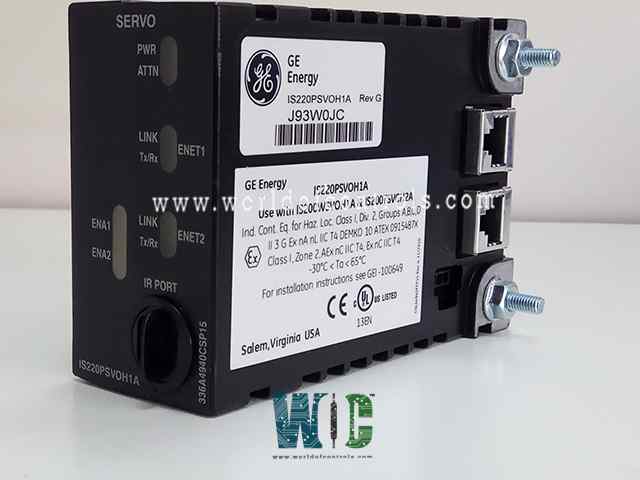
World Of Controls understands the criticality of your requirement and works towards reducing the lead time as much as possible.
IS220PSVOH1A, REV C - Simplex Servo Control I/O Module is available in stock which ships the same day.
IS220PSVOH1A, REV C - Simplex Servo Control I/O Module comes in UNUSED as well as REBUILT condition.
To avail our best deals for IS220PSVOH1A, REV C - Simplex Servo Control I/O Module, contact us and we will get back to you within 24 hours.
SPECIFICATIONS:
Part Number: IS220PSVOH1A, REV C
Manufacturer: General Electric
Series: Mark VIe
Microprocessor: Intel Celeron 650 MHz
Number of inputs: 8
Power supply voltage: 28 V dc
Memory: 128 MB SDRAM
Number of outputs: 2
LVDT Excitation Output: 3.2 kHz
Programming: Boolean
Product Type: Simplex Servo Control I/O Module
Voltage Range: 14 to 32 V dc
Maximum Lead Resistance: 15 Ohm
Operating temperature: -30 to 65°C
Technology: Surface mount
Size: 8.26 cm high x 4.19 cm
Repair: 3-7 Day
Availability: In Stock
Weight: 2 lbs
Country of Origin: United States
Manual: GEH-6721D
FUNCTIONAL DESCRIPTION:
IS220PSVOH1A, REV C is a Simplex Servo Control I/O Module manufactured and designed by General Electric as part of the Mark VIe Series used in GE Distributed Control Systems. The PSVO I/O pack is the electrical interface between one or two I/O Ethernet networks and a TSVO servo terminal board. It includes a processor board shared across all Mark VIe distributed I/O packs and a dedicated I/O board for servo functions. Using the adjacent WSVO servo driver module, it manages two servo valve position loops with selectable output currents ranging from 10-120 mA DC. Additionally, the pack provides LVDT excitation, supports eight LVDT feedbacks, and processes two pulse rate inputs from fuel flow meters. The pack receives input via dual RJ45 Ethernet connectors and is powered by 28 V DC supplied from the terminal board. Output is delivered through a DC-62 pin connector that interfaces directly with the terminal board. Diagnostic features include indicator LEDs for visual monitoring and an infrared port for local serial communication diagnostics.
OPERATION:
The processor board interfaces with an acquisition board tailored to the I/O pack's function. When input power is applied, a soft-start circuit gradually increases the voltage to the processor board. Local power supplies are sequentially activated, and the processor reset is released. The processor then performs self-tests and loads application-specific code from flash memory. This code verifies compatibility with the board ID to ensure proper alignment between the application code, acquisition board, and terminal board. Once verified, the processor initiates Ethernet communication by requesting a network address via the DHCP protocol, using the unique ID from the terminal board. Following Ethernet setup, the processor configures on-board logic, executes the application, and activates the acquisition board for operation.
The processor application code is designed to support operation with one or two Ethernet inputs. Both network paths remain continuously active when two inputs are used, ensuring uninterrupted I/O pack functionality even if one network fails. Any failure is reported via the remaining active connection, offering greater fault tolerance compared to traditional hot-backup systems, which rely on a secondary port only after detecting a primary port failure. The Ethernet ports on the processor automatically negotiate between 10 MB/s and 100 MB/s speeds, as well as between half-duplex and full-duplex modes. The processor board in the pack is common to all Mark VIe Ethernet I/O packs. It contains the following:
INSTALLATION:
WOC has the largest stock of OEM Replacement Parts for GE Distributed Turbine Control Systems. We can also repair your faulty boards and supply unused and rebuilt boards backed up with a warranty. Our team of experts is available round the clock to support your OEM needs. Our team of experts at WOC is happy to assist you with any of your automation requirements. For pricing and availability on parts and repairs, kindly contact our team by phone or email.
What is the primary function of the PSVO I/O pack?
The PSVO I/O pack is the electrical interface between I/O Ethernet networks and the TSVO servo terminal board. It supports servo valve position loops, LVDT feedback, and pulse rate inputs from fuel flow meters.
What components are included in the PSVO I/O pack?
The pack includes a processor board common to all Mark VIe I/O packs and an I/O board specific to servo functions. It also uses the WSVO servo driver module for managing servo valve outputs.
What type of input and power connections does the pack use?
Input is received via dual RJ45 Ethernet connectors, and the pack is powered by 28 V DC supplied from the terminal board.
How does the PSVO I/O pack handle output?
Output is managed through a DC-62 pin connector that directly connects to the terminal board.